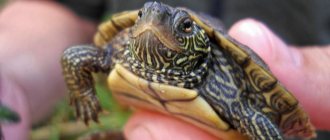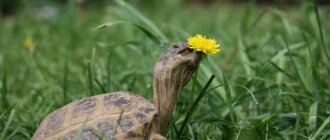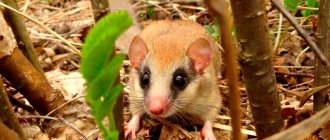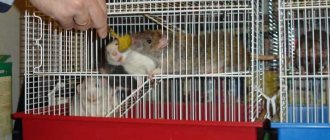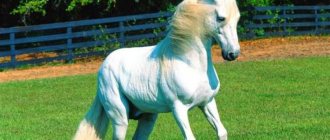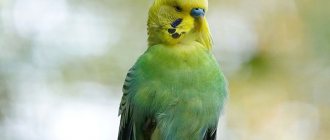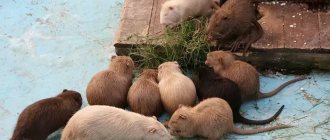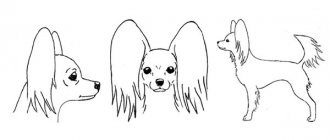Review author: “ZooVita”
Turtles are interesting animals. They have been very popular in Europe for many years, and for good reason. They do not create problems when it comes to care, but breeding these reptiles requires the owner not only to acquire knowledge, but also to be willing to deepen it.
Red-eared slider: the most popular species
Residents of megacities prefer to keep this sea turtle most often . With proper care, it can please its owners for at least 30 years!
It is believed that 15 subspecies of this breed. A characteristic external feature of all of them is red or yellow spotslocalized in the ear area. The paws have stripes of a rich green hue. The height of such individuals is within the range of 18-30 cm.
The red-eared turtle stands out with its markings
IMPORTANT: To determine age, it is recommended to pay attention to the shell. The younger the turtle, the lighter its shell.
These beauties are accustomed to living in swampy reservoirs and ponds in the USA, Mexico, England, Israel, Spain and Australia. Therefore, of course, a pond for your pet. But not in the form of a basin with water and a pebble.
We need a larger aquaterrarium with lamps, filters, and a thermometer . water should be approximately 28 degrees, and the air should be 32. The ideal solution would be to build an island in the middle of the turtle's residence.
feed your pet small crustaceans, fish fry, and small boneless fish. He also loves the larvae of small frogs and insects. A small number of plants will successfully season a dish.
IMPORTANT: It is worth getting several red-eared turtles at once. Their fun games will amuse both children and adults.
Red-eared turtles are fun to keep in groups
Land reptiles
The land turtle is incredibly slow compared to the freshwater turtle. Please note that when an animal is frightened, it immediately hides its head under its shell.
There are giant individuals, but small or very tiny ones, up to 10-12 cm, are suitable for the home. On average, they live at home for 30 years.
Central Asian tortoise: the most delicate to handle
Despite the fact that this beauty is present in the Red Book , you can purchase it without any problems. This is what many animal lovers use. Oddly enough, despite its delicate status, this turtle is often found in captivity. And in the wild - in Central Asia.
This most popular land turtle does not like confined spaces . That is why in captivity she is capricious and may even die.
However, if the owner takes care in arranging the pet’s home, the turtle can feel quite comfortable. That is, you need to prepare a spacious house - an enclosure with a volume of at least 100 liters. A dwelling requires the presence of not only soil, but also sand and pebbles. The Central Asian turtle is passionate about digging holes, so it will be delighted with such flooring.
The diet should include mainly foods of plant origin. Meat products are not for these beauties. The only thing is that sometimes you can treat them to larvae and insects.
IMPORTANT: But in the most minimal quantities!
This extremely slow pet is distinguished by its yellow-beige color, with dark inclusions. The length of the shell is 20-25 cm.
This is what the Central Asian land turtle looks like
Pros and cons
If we consider the most common types of domesticated turtles, we can say that they are unpretentious, easy to care for and not demanding. For example, if a hamster or guinea pig does not receive enough ascorbic acid, then it gets scurvy... When a land turtle is forgotten to add water to its drinking bowl for several weeks, it will only start drinking more greedily.
Of course, even among these reptiles there are more capricious individuals; nevertheless, less problematic representatives are often kept as pets. Naturally, it is not recommended to test the strength of your pets. Most animals of this species have the following advantages:
- they need little food, the diet is simple and unpretentious;
- turtles are silent pets that do not make unpleasant sounds;
- there are several types of these reptiles: some live on land, others in the water element, others are semi-aquatic - which means you can choose the most suitable pet;
- do not smell and do not cause allergies;
- most reptiles feel good at low temperatures - falling into suspended animation, they are able to live at 0°C for several months;
- reptiles are most often long-lived - in captivity their life expectancy is 15-50 years;
- and another plus - you won’t have to run after the running animal.
With all the positive qualities, turtles also have disadvantages, which it is advisable for the owner to know about before the original pet appears in the house. The disadvantages include the following:
- The enemy of turtles is drafts, they often catch colds, and treating fossil reptiles is quite difficult;
- often owners lose sight of the fact that these pets can also become infected with worms and other parasites, in which case deworming is required;
- if kept freely, the turtle can get underfoot and relieve itself in the wrong place;
- communication with a reptile is not so “warm” - it will not joyfully wag its tail, fawn, purr or jump into your arms. However, they can be very sociable - it is only important to catch the changes in the pet’s behavior when the owner appears.
Trionix Chinese: the most unusual turtle
Another pet that can be found in the Red Book. But it is remarkable not even for this, but for the fact that it truly looks amazing. Trionix belongs to the so-called “soft-bodied” turtles. That is, its shell is completely soft due to the fact that it is covered not with horny plates, but with skin. is also amazing . On the muzzle there is a proboscis with large nostrils . The length of an adult is 40 cm.
Trionix chinensis has a rather unusual muzzle for a turtle.
The lack of an armored house of these reptiles is more than compensated by the presence of sharp claws and teeth. And also quite a fighting character. If Trionix intends to bite, then the bite will be quite noticeable. And, moreover, traumatic.
IMPORTANT: Therefore, it is strongly recommended to purchase such a turtle at a young age - it must get used to its owner. Only then will Trionix not be aggressive.
Chinese amphibians love fresh water and soft soil. The home of such a pet should be spacious and closed. water temperature to 25-32 degrees. Of course, it is important to take care of filtration, aeration, sufficient light and heat.
Trionix loves protein foods . You can feed him fish, bloodworms, insects, shellfish, meat, and worms. However, you should always remember that Trionics are greedy, so it’s easy to overfeed them beyond the norm.
Trionix Chinese is an unusual turtle that can be used to create an unusual aquarium at home
Some tips
What age should I take a turtle?
Baby turtles are more susceptible to disease than adults and are more likely to die or grow crooked if not cared for properly. Also, with small turtles, it is more difficult to carry out medical procedures, both for the veterinarian and for you. So if you don’t want your child to be upset and cry over a deceased pet, it’s better to buy a teenage or adult turtle.
What time of year is best to get a turtle?
You should get a turtle in the summer, as at this time they are more active, and it is easier to distinguish a healthy turtle from a sick one. In addition, there is less chance of the turtle catching a cold while being transported from the place of purchase to the house. Purchasing equipment and terrariums is also more convenient in the warm season.
When buying a turtle in winter, in 9 cases out of 10 you will receive a sick animal that was not sold in the summer due to its “unmarketable appearance” or market congestion. When buying a smuggled animal (a land turtle), you must clearly understand that for one surviving turtle, there are several dozen who died during transportation and subsequent detention in conditions of high crowding and lack of heat, light and ultraviolet radiation.
European Swamp Turtle: Hibernating Pet
The main external distinguishing feature of this turtle is its completely black color with occasional yellowish splashes. The shell of this individual is smooth and flatter than that of other turtles. Another distinctive feature is the long tail. Without exaggeration, it takes up ¾ of the length of the turtle itself. Moreover, the length itself is within 35 cm.
Such an amphibian is not considered exotic in our country - it is accustomed to living in Belarus, Russia, Georgia, and Armenia. Ponds and lakes are ideal habitats for these turtles. Since it can be cold in our regions, from about October until the end of winter the turtle hibernates .
As for keeping it at home, you need to take into account the temperature that will have to be maintained. The water temperature should ideally be 22-25 degrees, the air temperature should be 30. Also, pets should definitely have their own personal island on which they will relax.
Swamp turtles prefer fish, meat, insects and crustaceans. It is also recommended to give mineral supplements . It is curious that such a turtle can be taught to take food from tweezers - since it is a predator, it is not short of intelligence.
IMPORTANT: You need to remember that adults should be fed 2 or 3 times a week, and young ones - every day.
This is what a European marsh turtle looks like
Testudo hermanni
Light brown shell with dark pattern. Balkanskaya grows up to 20 cm.
Externally, the turtle looks like a Mediterranean “tribesman”. The color changes over the years, eventually becoming yellowish-gray.
Tail with a horny tip. Loves peas, beans, clover, fruits. You can diversify the menu with slugs and snails. You will find out what to feed pet turtles in the next article.
Musk turtle: miniature turtle
The length of the shell of this turtle, accustomed to living in the southwestern part of the United States, is only 13.5-14 cm. However, in addition to its compactness, it has something to surprise. This amphibian is surprisingly unpretentious . Any room temperature will be accepted with a bang.
Like any food. Small fish, shrimp, algae, insects, cabbage, salad - the turtle will eat all this with pleasure. She also loves meat , as in natural conditions she is accustomed to eating carrion. Therefore, there is a high risk that your pet will slightly pollute the water. In this regard, it is recommended to either feed him with food on a stick , or clean the aquarium more often.
However, despite the ease of keeping, the musk turtle can present a surprise if it senses approaching danger. And this will be a frequent problem unless she gets used to her owners from childhood. The glands located under the shell emit a rather repulsive odor.
IMPORTANT: Don't be alarmed by the fact that turtles spend most of their time underwater. This is completely normal for this species.
The musk turtle loves to move along the bottom most of all.
Water representatives
Aquatic pet turtles are diverse. These reptiles have membranes on their limbs.
Most species inhabit water bodies where water movement is weak. There are both carnivorous and herbivorous reptile species.
Mediterranean tortoise: a heat-loving pet
The second name for this turtle is “Greek”. And it has about 20 subspecies . The largest representatives can boast a shell 35 cm . On the hind legs there are peculiar spurs and small horny tubercles. The front paws are marked with claws, 5 pieces on each.
In the wild, turtles live in a wide variety of climatic conditions. Since the range extends throughout the European south. Shrubs in the mountains, open forests, steppes, semi-deserts - this beauty will be comfortable everywhere. the Greek tortoise has no equal in terms of thermophilia
Accordingly, a lot of light and warmth are needed in captivity. is preferable to choose a lamp with a power of at least 40 W. And best of all - 60. This reptile is smart enough, so it will choose the mode it needs on its own - it will either move away from the lamp, or move closer to it.
IMPORTANT: But, of course, nothing can replace real warmth from the sun. Therefore, if the weather is good, you definitely need to take your pet for a walk.
Greek turtles prefer to eat plant foods. Foliage, grass, berries, fruits are the most delicious food for them. However, snails, slugs and insects can also keep them happy.
The Mediterranean tortoise is a big fan of soaking up the sun.
Life of reptiles in the wild
Sea turtles live in the Indian and Pacific Oceans. There are reptiles in the Atlantic. They spend their entire lives in the water, coming ashore only to lay eggs. On land, reptiles are extremely slow, but in the sea they are tireless swimmers.
What do sea creatures eat? Small turtles prefer to feast on zooplankton and small nekton, while large individuals love plant foods, but will not refuse small sea inhabitants.
In one year of nesting, the female makes more than five clutches, in each of which the number of eggs can reach up to 200 eggs. Having laid eggs, the turtle swims away - it does not return to the place of laying.
FACT! The sex of the future turtle depends on the conditions and temperature. When the weather is warm, females appear; when it gets cold, males appear.
The development of future turtles in the egg lasts two months. If temperature changes occurred during this period, the masonry may completely die.
The hatchlings are removed from the shell using an egg tooth. Once hatched, they immediately become potential food for sea, land and air predators. Few manage to survive.
Egyptian tortoise: a mysterious pet
Despite the fact that this species has been known to science for more than a century, its habits are still little studied. However, scientists immediately noticed that at the slightest sense of danger, turtles begin to actively bury themselves in the sand. In Egypt, Libya and Israel, where they come from, this is not difficult to do.
Of course, similar conditions should be recreated at home. Some Egyptian owners prefer to cover the terrarium with sand, while others mix it with soil. But experienced turtle owners strongly recommend adding shell rock - it gives some hardness to the soil and serves as a source of calcium. shelter for the turtles - this way they will feel more comfortable.
The temperature should be about 22-24 degrees . From about October to April it needs to be lowered , since at this time the turtles hibernate.
Pets can be once a week . They love to eat plants of the genus Artemisia, herbs, salads and even hay as a source of coarse fiber. is also important .
IMPORTANT: Egyptian tortoises should not be kept alone. It is preferable to choose a pair. Better yet, keep a group of pets.
Egyptian tortoises love sand
Testudo kleinmanni
"Egyptian" has a sandy colored shell with black spots. It reaches 12 cm. Males are larger than females. Picky about content. They get sick easily.
Preference is given to herbs of the wormwood genus. Be sure to add calcium and vitamin D3. Gender can only be determined at age 15.
Caspian turtle: pet climbers
Despite its name, the turtle lives in the wild not only in the Caspian Sea. The lands from southern Europe to the Middle East are also familiar to them.
You can recognize such a turtle by its large – up to 30 cm – dark green shell. You can also notice yellow stripes , and not only on the shell.
Comfortable keeping at home involves setting the water temperature within 18-22 degrees , and the air temperature from 30 to 32. It won’t hurt to create a mound of pebbles, since Caspian turtles are also rock climbers. They also love the abundance of vegetation in reservoirs, which the owner can use to decorate the terrarium.
The reptile alternates meals with sunbathing and minutes of silence in the grass. As soon as night or hibernation , she hurries to bury herself in the mud. By the way, the pet will spend most of its time under water.
IMPORTANT: Therefore, the water should be changed at least once a week.
The menu should consist of both animal and plant foods. In the first case, these are fish, meat, worms, bloodworms, insects, and tadpoles. In the second - common and sea cabbage, bananas, seaweed, carrots, leaves from various plants.
This is what a Caspian turtle looks like
Indian tortoise: the most beautiful tortoise
This reptile is also called “star-shaped”. This name refers to admiration for the unusual shell. It is lumpy and has patterns that resemble stars. It must be said that the yellow patterns stand out quite impressively against a black background. The length of these reptiles is within 25 cm.
This beauty prefers to eat plant foods. Carrots, apples, pumpkin, zucchini, lettuce, alfalfa, and dandelions are ideal.
It’s worth looking at a larger terrarium as a home , and it needs to be furnished warmer. From 27 to 32 degrees air is the norm. If you place several star turtles in it, they will coexist extremely peacefully with each other. Even males will not compete for territory. However, turtles will also make friends with other pets.
The pet will delight its owners all year round, since it does not need hibernation. After all, in his homeland - in Hindustan and Sri Lanka - there is no cold weather.
IMPORTANT: With proper care, an Indian turtle can live 80 years!
The star tortoise is a pet with a truly exotic appearance
How to keep turtles at home?
To keep pet turtles, you need to set up a special aquarium or terrarium. If the turtle is land - a terrarium, if the turtle is aquatic - an aquarium. They should not roam freely around the apartment.
Usually, special containers for an aquarium or terrarium made of glass are used. To create suitable conditions, heaters or special lamps are used.
If the turtle is a land turtle, a house is usually made for it, installed in a terrarium. She will sleep and relax in it. In the case of an aquatic turtle, be sure to install a filter in the aquarium, ensure aeration of the water and make a small dry island inside.
It is better to use hay as soil in the terrarium. Do not use sand, turtles swallow it, which is harmful to their health. Sand can be used as a base, but hay or large pebbles must be placed on top.
Mud turtle: an undemanding pet
The second name for the reptile is “big-headed”. Her head is indeed so disproportionately large in relation to her shell that it looks unusual. The paws are also large. In general, this turtle is ideal for those people who intend to have a small pet. The length of such turtles does not exceed 18 cm.
By the way, small sizes imply undemandingness in choosing a home. If for some breeds you need to buy large terrariums, then that reptile will cost you a capacity of 60-100 liters. They also have no need to create islands - mud turtles prefer to live in water. The only thing is that females may want to crawl onto land during the period of laying eggs.
They prefer to eat food of animal origin. Fish, shellfish, and lean meats are excellent. Worms and tadpoles will also brighten up the diet. As for snails, this is a topic for a separate conversation, since the loggerhead turtle simply adores them!
IMPORTANT: Despite its small parameters, a mud turtle can bite quite noticeably. Therefore, handling it requires care.
Mud Turtle
The turtle is considered one of the most ancient creatures on Earth. And so many of its species have appeared today that one article is not enough to describe it - more than 300 . Of course, not all of them are suitable for home keeping. And we hope that this rating will help those who dream of becoming turtle owners decide.
Varieties of pet turtles
All types of domestic turtles are usually grouped into 2 main categories - aquatic and land. They differ in the structure of the body, requirements for living conditions and nutritional characteristics. Therefore, before purchasing a turtle, be sure to study in detail the characteristics of the chosen species to ensure proper nutrition and living conditions.

